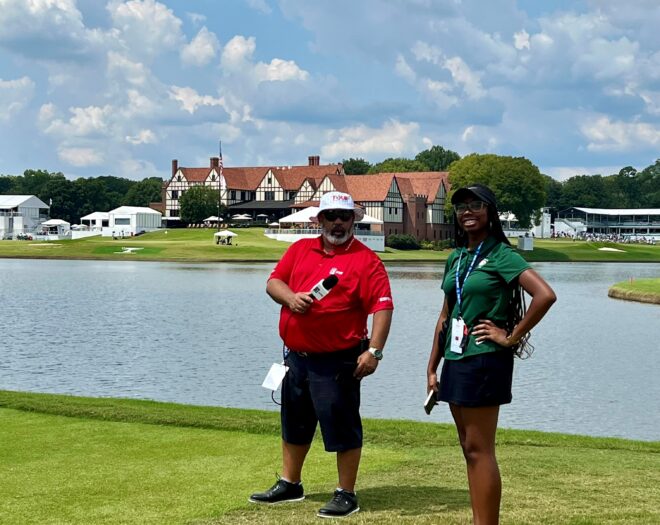By John Kim
PGA.com Coordinating Producer
ATLANTA — Upon the conclusion of THE TOUR Championship presented by Coca-Cola, there will be two stories celebrated on the 18th green. One will celebrate the winner of the championship, the other will honor the winner of the inaugural FedExCup. Both stories are exciting, compelling and worthy of lots of press.
Less than a pitching wedge away, though, a few yards removed from the golf course, is the story of the true winners of THE TOUR Championship — the East Lake community that has undergone one of the most dramatic and revolutionary revivals in modern history. It is a story of partnership, the triumph of the human spirit and a belief that good can overcome the most hardened evil. It is a story of grand prominence, a tragic ruination and an almost biblical rebirth. It is a story of a golf course, a neighborhood and a golf tournament — and how all three work together to make the future a little brighter than it was before.
It is difficult to overstate the importance of East Lake Golf Club to the development of golf in the United States, or to overstate the depths of how far it had fallen on a golf or community scale.
Renowned for producing golf legends such as Bobby Jones and Alexa Stirling, East Lake Golf Club quickly became the hub of the nation’s golfing focus in the early 20th century. As the host of many prominent events and home to several top players, the club enjoyed decades as an icon of sports and high society.
But that lofty status took a tumble as the course and community became a victim of the civil rights strife and urban decay that gripped Atlanta in the late 1960s. The wealthy members of East Lake began to migrate to the suburbs, even establishing a new “home” club north of Atlanta. The property surrounding the course was sold to a developer who built low-income public housing on the land. That accelerated an already deteriorating community. The storied golf course, which had welcomed the world when it hosted the 1963 Ryder Cup, soon after became a blight to the Atlanta landscape. In fact, it became more than a blight — it would devolve into a veritable war zone.
The statistics that reflect how tragic the story of East Lake had become by the mid-1990s would be a stretch for even the most sinister fictional novel. But unfortunately for the residents of East Lake, the numbers only began to tell the very real story of the nightmarish neighborhood. In a ranking of criminal activity in the city of Atlanta, the East Lake neighborhood ranked dead last, no pun intended. The crime rate was an astounding 18 times higher than the national average and the main economic engine was the drug trade. The neighborhood, nicknamed by Atlanta police as “Little Vietnam,” was trapped in a cycle of poverty and crime that only seemed to spiral deeper, no matter how many millions of taxpayer funds were invested to help it out.
And the golf course, the only American course to have produced two British Amateur champions back when the British Amateur was considered a major championship (Bobby Jones in 1930 and Charlie Yates in 1938), mirrored the surrounding community in its fall from grace. Conditions and memberships deteriorated until the East Lake Golf Club was only a golf club via technicality. Though a few hardcore purists remained as members, those who braved a round at the course were as concerned about stray bullets as they were about stray tee shots.
Enter Tom Cousins, a lifelong member of East Lake and one of the nation’s top real estate developers. In 1993, he, along with a charitable foundation, purchased the dilapidated golf club with a vision to restore it to its one-time grandeur and make it a worthy tribute to its most famous member. But even more, he believed he could use the restoration of East Lake Golf Club as a catalyst for social revolution in the surrounding area. And Cousins had no interest in a “quick fix” — displacing one community and replacing it with a higher-income version. No, Mr. Cousins had a vision to elevate the entire community — residents included — and have East Lake serve as a focal point for the golf world and for urban renewal.
Noble? Of course. Possible? Well, that was a question many asked. For starters, as much as East Lake residents feared their neighborhood, it was their neighborhood. They were not convinced that they could trust the altruism and intentions of an outside agency to build a better community and allow them to live in it.
“Here was a group of people that had been abandoned by every institution around them,” explained Carol Naughton, the executive director of the East Lake Foundation. “Banks, the government, even the police — they really had no one they could rely on. Now, here we come claiming that we really are here to help them out. Who could blame them for being so cynical? It often took months for someone to come and fix a toilet for them, and now here is this group of outsiders claiming that we’ll just come in and fix their entire neighborhood? They were very skeptical of us, and that was understandable.”
That cynicism only increased when it was announced that the intention of the Foundation was to tear down much of the existing housing and build new homes in its place. In fact, many of the residents even became hostile at the thought.
But the Foundation members would not be deterred, no matter how much adversity — even outright opposition — came their way. As the Foundation demonstrated commitment and sincerity, residents eventually grew to trust its intentions and motives. New homes were built. A charter school was established for residents. The golf course was renovated. And a new East Lake was born, looking very much like the old East Lake — the one from the early 1900s.
In a dozen years since the reemergence of the East Lake community, the numbers are already overwhelmingly positive. Violent crime has been reduced by 95 percent since 1995. All adults receiving government housing assistance are required to either be working or in a job training program. The Drew Charter School boasts an 88-percent rate of students who meet or exceed state standards for reading and 74 percent that meet or exceed in math. In 1995, the number for area students in the math portion was 5 percent. And 100 percent of alumni from Drew Charter School are on course to graduate from their respective high schools. Fewer than a third could say that back in the mid 1990s.
Furthermore, The Villages of East Lake is a beautiful, thriving mixed-income community with a diverse population that shares a common goal of bettering the community. But the numbers aren’t nearly as compelling as the smiles and the optimism that pervades the faces of the neighborhood youth as they take part in a multitude of after-school opportunities, including the famous First Tee program, which had its origins at East Lake.
And of course, there’s still the golf. East Lake Golf Club has once again positioned itself as one of the greatest and most important venues in the golf world as it is now home to THE TOUR Championship presented by Coca Cola, the finale of the PGA TOUR Playoffs for the FedExCup.
So Sunday afternoon, the winner of THE TOUR Championship will get $1.5 million. The winner of the FedExCup Playoffs will receive a $10 million bonus. But the residents of East Lake, via the East Lake Foundation, which receives the net proceeds from the tournament, know that there are multiple winners, hundreds of them, each year that the TOUR comes to town.
But the story is not complete. The revitalization of this neighborhood and this golf course should be a starting point, a first step in a story of many communities that can experience the same type of “community miracle.” Thus, the rebirth of East Lake is not only a great story to tell, it is an important story to share. And therein lies the rub. Who will serve as the next Tom Cousins and invest in his or her own community? How many people are there who will commit the time, dedication, money and sweat equity to make their neighborhoods a better place for everyone?”
There are too many areas that need this same type of attention and commitment,” said Rob Johnston, the chairman of THE TOUR Championship and a member of the Board of Directors for the East Lake Foundation. “There are too many people who deserve the same chance.”
Sounds like a Hollywood ending — but it’s a great true story in the heart of Atlanta.





